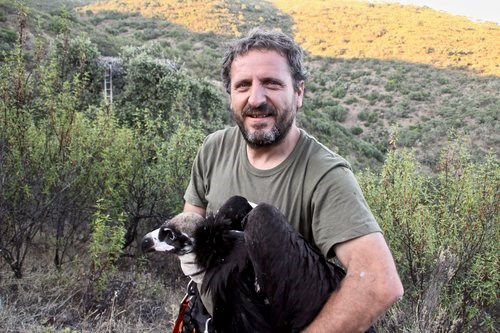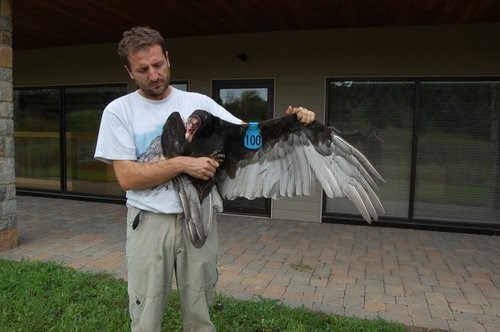Trainee to International Conservation Pioneer
Posted on in In the Field by Alfonso Godino, Research Associate
The cinereous vulture was extinct in Portugal as a breeding species at the end of the 20th century, but in 2010 a new colony was established in Tejo Internacional National Park, in the eastern limit of the country and close to the border with Spain.
This colony now hosts 18 breeding pairs, and no studies were done before out of the annual breeding monitoring implemented by the Natural Park’s staff. Due to this lack of information, and being the main population in Portugal, our goal is to get information about the dynamic of this colony. Thus, the first step is to study the juvenile dispersion and the potential causes of mortality of this population.

During the summer of 2018, eight nestlings were tagged with GPS-GSM transmitters, supported by Hawk Mountain Sanctuary and the Spanish electric company ENDESA. This support will continue during 2019, with the goal to increase the number of birds in this study and to get more accurate and representative information.
All this information will be shared with the Natural Park’s managers, with the objective to facilitate them the conservation and management of the colony, since all the nests of this colony are in private estates inside the protected area.
But how did HMS reach Portugal? During 2009, I was at Hawk Mountain as a trainee. I was an enthusiast in vultures’ conservation, and HMS offered to me the amazing opportunity to trap turkey vultures and to use wing tags for the first time in my life. But for me, the most impressive was to get access, for the first time in my life, to the huge amount of information about raptors in the Sanctuary library. I spent many days reading papers and copying a lot of info to bring with me after my traineeship. From that time, I was interested in vultures’ juvenile dispersion but never had the opportunity to be involved in a project with this objective.

And again, after almost a decade, a causality joints me one more time to HMS, but this time in Portugal, not in Pennsylvania.
In this new cinereous vulture’s project, HMS is more than a sponsor offering GPS devices. From the beginning of the proposal to HMS, its permanent support and fast reply have encouraged me to work in this project, especially during the hard times of preparations, authorizations, organization, etc. I am sure that the presence of HMS in the project has been a motivation to other bodies to participate and be part of it. The result has been the creation of a task force, where raptor conservation and research organizations such as HMS, a private company such as the Spanish electric company ENDESA, and the government of Portugal, are in a narrow collaboration to study and protect the cinereous vulture in this colony.
Now, with the vultures sending throughout the transmitters lots of daily data, it is time to enjoy learning how these vultures move around the Iberian Peninsula and, who knows, maybe one of them cross the Gibraltar strait toward Africa and offer us new and unexpected information about the movements of this species to sub-Sahara regions!
Check out this video of Alfonso and his team tagging and releasing a cinereous vulture!